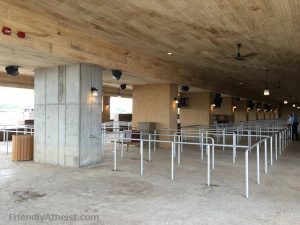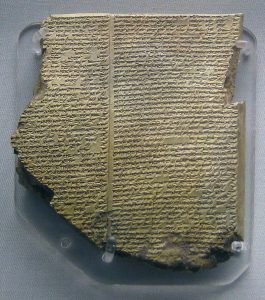
Noah’s Ark is one of those mythical ideas that continues to find its way in both the fringe and the mainstream media. This week, Ken Hamm unveiled his new theme park based on Noah’s Ark. You’d think that the premier week would be the largest turn out, but the videos I saw say otherwise. You might say, “well, wait until the weekend!,” but it’s summer in what seems to me to be the homeschool capital of the United States, so I would’ve expected the throngs that Six Flags and amusement parks are getting.

Nope. At around 1:00 PM on opening day, The Friendly Atheist reports the queues were empty.
But this isn’t an article about Hamm’s version of Noah’s Ark, it’s about the recent news by Dead Sea Scroll researchers about the ark’s appearance. As Jason Colavito says, “Fringe writers have gone a bit bonkers [over the fact that] the author of one of the scrolls considered Noah’s Ark to be pyramidal in shape.” ((
Fringe Writers Shocked By Text from Dead Sea Scrolls Claiming Noah’s Ark was Pyramid-Shaped))
Apparently the new information about the ark comes from the application of high-resolution photography: each fragment of the scrolls is photographed 28 times at differing wavelengths of light, allowing parts of parchment that had been burned, erased, or otherwise illegible to be visible. ((Was Noah’s Ark Shaped Like a Pyramid? Digitized Dead Sea Scrolls Reveal New Secrets))
At a recent conference on the Dead Sea Scrolls, Dr. Alexey Yuditsky, a researcher at the Academy of the Hebrew Language, discussed a section on Noah’s Ark that included a previously illegible word, ne’esefet, which was revealed with the new photographic methods being employed. The section that included ne’esefet was already understood to refer to “the ark’s tallness.” Yuditsky’s interpretation of ne’esefet is that it means “gathered” and that the section is describing the ark’s ribs, which were “gathered together at the top,”–that the roof tapered to a point.
Of course, Yuditsky probably didn’t say the word “pyramid” at the conference. He certainly isn’t quoted as using it in the Haaretz article on June 28. But that doesn’t stop the fringe community from leaping straight to it!
At ancient-code.com, they put it right in an article title ((New study of the Dead Sea Scrolls reveals Noah’s Arc was shaped like a Pyramid)). They write, “According to Yuditsky, this fragment of the text is interpreted as a pyramidal shape.”
Mysteriousuniverse.org goes a bit further with their title, which just comes right out and says, “Digital Analysis of Dead Sea Scrolls Says Ark Was a Pyramid.” Not pyramid-shaped, pyramidal, or pyramid-like, but and actual pyramid! They do, however, include an interesting video from the Israel Antiquities Authority that shows a DSS fragment under various wavelengths. It reminds me a bit of using DStretch, a plugin for ImageJ that does a similar job.
[youtube MY-8AQZOe_w]

What the fringe and the mainstream are missing in their reporting is the perspective provided by the lens of mythology.
The Dead Sea Scrolls date to between 400 BCE and 300 CE ((Doudna, G. (200) “Carbon-14 Dating”, in Encyclopedia of the Dead Sea Scrolls, Schiffman, Lawrence, & VanderKam, James, eds., Vol.1, Oxford)). The most conservative, hardcore religious (read: young-earth creationists) estimates put Noah’s Flood at around 2348 BCE since the flood took place 1656 years after creation which was in 4004 BCE.
This, of course, is nonsense since we have many, many archaeological sites that go unbroken during this period, showing no destruction layers or lack of continuity you might expect from such a global catastrophe. Indeed, continuity exists in the archaeological record in all suggested periods of time for the Noachian flood myth.
And there’s a reason. It’s a myth. Borrowed from a much earlier story. One that can be dated to around 2100 BCE ((Dalley, Stephanie (1991). Myths from Mesopotamia: Creation, the Flood, Gilgamesh, and Others. New York: Oxford University Press. )), a little before the supposed date of the Noachian story.
Demonstrably, the Gilgamesh epic is a literary progenitor of the Noachian myth. I’ll include passages from both Genesis and Gilgamesh here in a line-numbered format to compare:
1.
2. At the end of forty days
3. Noah opened the window he had made in the ark and released a raven,
4. Which flew back and forth as it waited for the waters to dry up on the earth
5. Then he released a dove to see whether the waters were receding from the earth
6. But the dove, finding nowhere to perch, returned to the ark, for there was water over the whole surface of the earth. Putting his hand out, he took hold of it and brought it back into the ark with him.
7. After waiting seven more days, he again released the dove from the ark.
8. In the evening the dove came back to him and there in his beak was a freshly-picked olive leaf! So Noah realized that the waters were receding from the earth.
9. After waiting seven more days, he released the dove and now it returned no more.
–Genesis 8:6-12
Now Gilgamesh:
1.
2. When the seventh day arrived,
3. I sent forth and set free a dove.
4. The dove went forth but came back since no resting place was visible, she turned around.
5. Then I set forth a swallow
6. The swallow went forth but came back, since no resting place for it was visible, she turned around.
7. .
8. .
9. I then set free a raven. The raven went forth and, seeing that the waters had diminished, he eats, circles, caws, and turns not around.
–Gligamesh XI, 145-54
The first lines in each story above refer to the receding flood waters but in different ways. In the Gilgamesh passage, I left two blank lines to maintain the correlation between the two and show the parallels. The Genesis passage shows clear embellishments (lines 7 and 8), a common literary device of the period. I took the Gilgamesh passage from Pritchard ((Pritchard, James B. (1958). The Ancient Near East Volume I: An Anthology of Texts and Pictures, Princeton University Press., pp 94-95)).
There are clear parallels and evidence of borrowed motifs between earlier flood myths and the Noachian one and you can apply this pattern throughout much of the biblical narrative. This isn’t evidence of “intellectual dishonesty” on the part of the authors of Genesis and other books of the bible, rather this is evidence of the practice of the day. Nomadic and semi-nomadic peoples (as well as many sedentary peoples) had strong oral traditions (and still do) in which they pass on information from one generation to the next which they find important or vital to their culture. In so doing, embellishments naturally occur in the evolution of the story. What may have once been a factually based account of a real event becomes convoluted and embellished to the point that it can only now be considered a myth. Myths and stories get embellished also due to the encounters of the story-tellers with other story-tellers.
We must consider that even Abram (later “Abraham”) admits that he is nomadic and originally Sumerian. The myths in question are, indeed, Sumerian (a.k.a. Chaldean). There is even emerging evidence of a diaspora in the Persian Gulf region, perhaps due to inundation of the Persian Gulf basin before 4,000 BCE, which may be the progenitor for the flood myths themselves. Certainly the origins of the Sumerians (they come from “Dilmun” according to their own writings, a place described as “eden” and “paradise”) is largely a mystery: their language is a linguistic isolate and their religion acculturates itself gradually -almost seamlessly- with the earlier Ubaid culture at around the Jemdat Nasr period (4000-3100 BCE).
So, in all the news about Noah’s Ark in the mainstream and fringe sources, don’t lose sight of the deeper, mythological evolution of the narrative.
Leave a Reply
You must be logged in to post a comment.